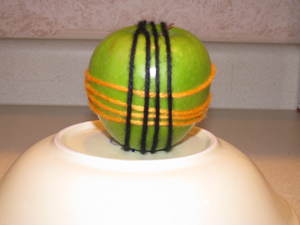There comes a time in every adults life when their child comes home with a worksheet that asks mysterious questions seemingly designed to make fools of the adults in the room. These questions are on a subject that most adults take for granted and in this day and age of GPS and Google, we rarely even give passing thought about.
The terms I speak of are not ones that are unknown only in the hallowed halls of learning but are terms that quite frankly are simply ones that we don’t often hear in our everyday life and if hard pressed, most adults will admit, they really didn’t understand the concepts the first time they were introduced in the classroom decades ago.
The terms are that of longitude, latitude, prime meridian, and the equator. When these terms come into your home, don’t panic but think of the world as you would an apple and learning will fall into place.
Using some yarn, ribbon or even colored string you have around the house, wind a few strands of yarn around the apple’s middle horizontally with one color (secure the yarn at the back of the apple using masking tape). Using another color (the more dramatic the color contrast the easier it will be for the student to understand the concept of longitude and latitude) wind the second colored yarn around the apple vertically for a few rounds. You do not have to cover the entire apple, all you are trying to do is make the concept clearer for the student, so a few strands will do quite nicely.
After wrapping the apple, ask the student which strand seems to be in a “long’ position. They will most likely point to the vertically wound yarn and you then will say, “that is longitude“. Using this as a starting point, then ask the student, “If that is longitude then which is latitude?” The student will then (usually most triumphantly) point to the horizontally wrapped part of the apple. At this point draw the yarn together showing the latitude around the middle of the apple into one area. Explain that this is the Equator which is the middle of the earth. Using this same principle, go back to the longitude yarn and draw it all into one bundle vertically as you explain that this line through the center of the earth vertically is also known as the meridian.
The use of an apple and some brightly colored yarn can make all the difference in the world to a student who needs hands on practice to understand the principles of longitude, latitude, meridian and equator. Sometimes all that is needed for the “light of understanding” to turn on is some practical experience, a little yarn and some simple language.
Note: This is a great class treat to take into your child’s classroom when they are learning about these terms. With some yarn you have cut into manageable pieces, masking tape and some simple practice, concepts which were once confusing can be made perfectly clear and in the process, kids can savor the taste of learning as well. The teacher will thank you for a “hands on lesson” and the kids will thank you for a tasty treat too!
